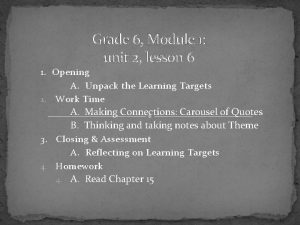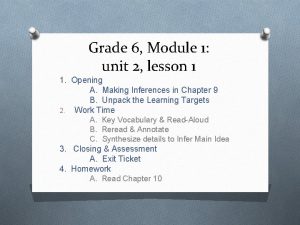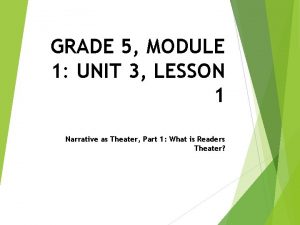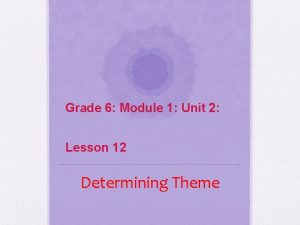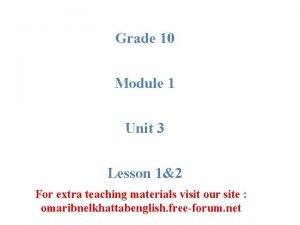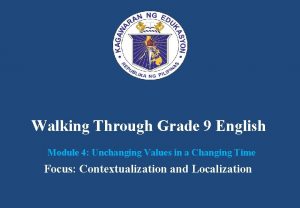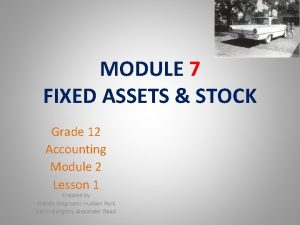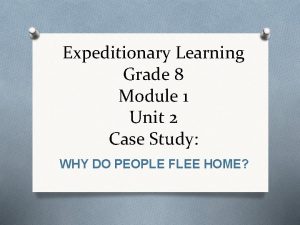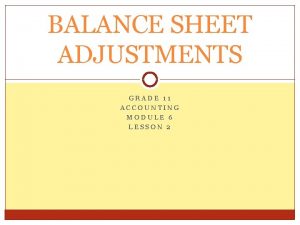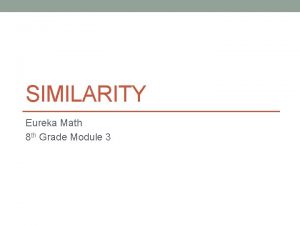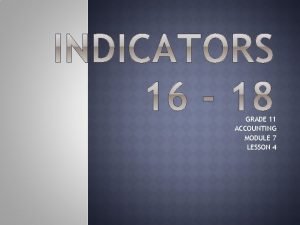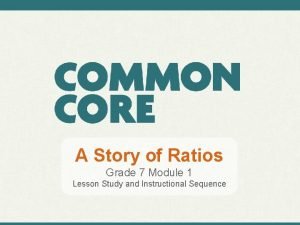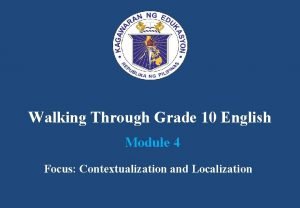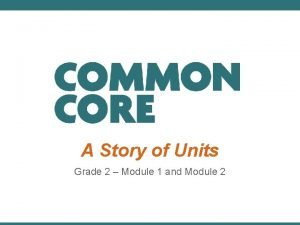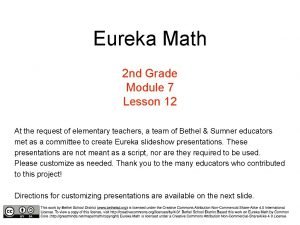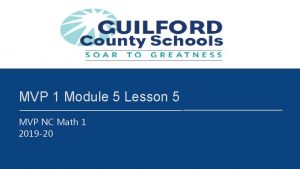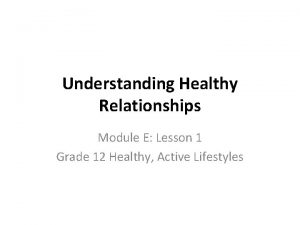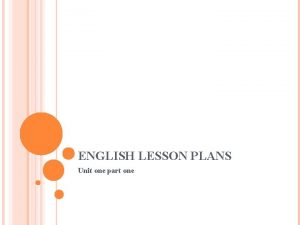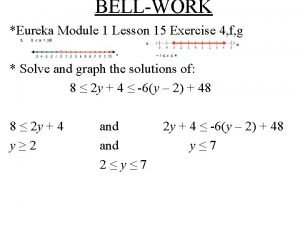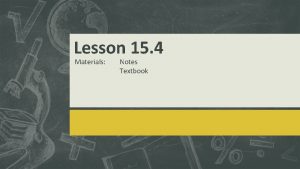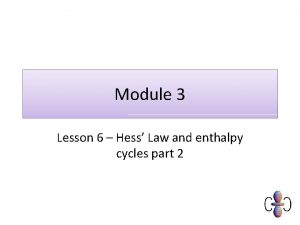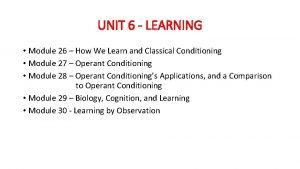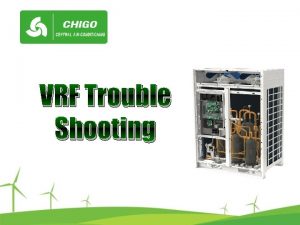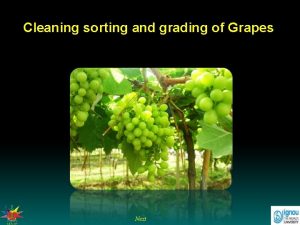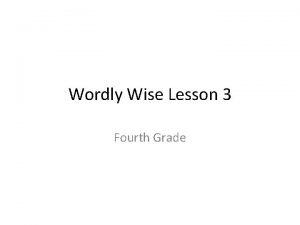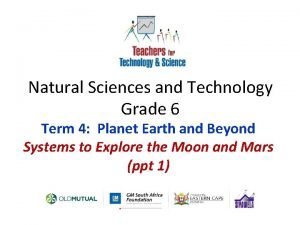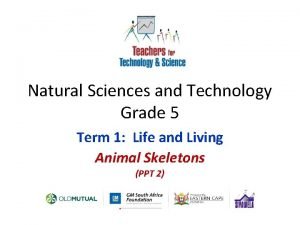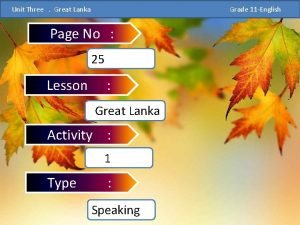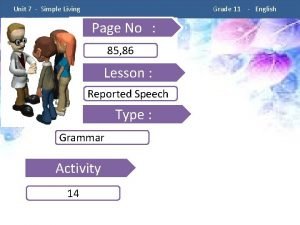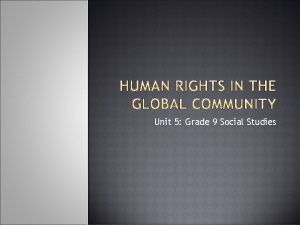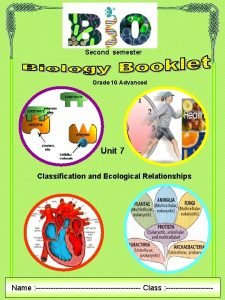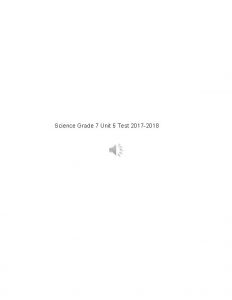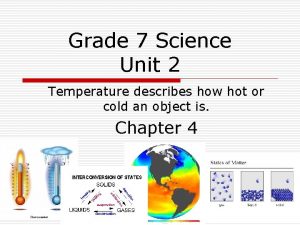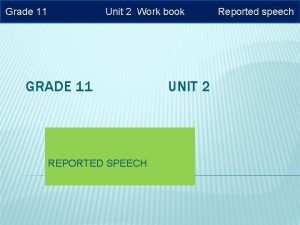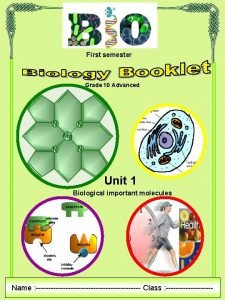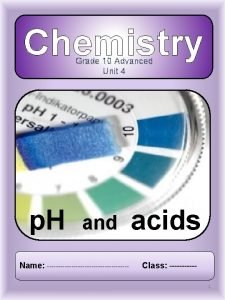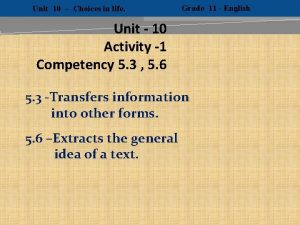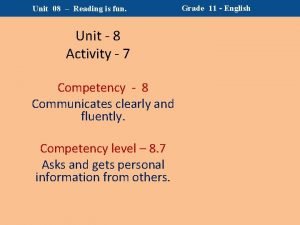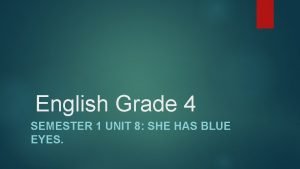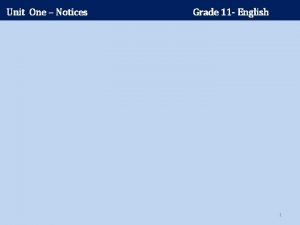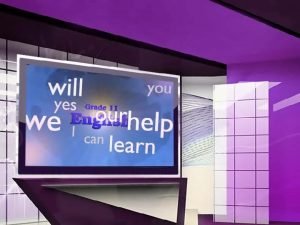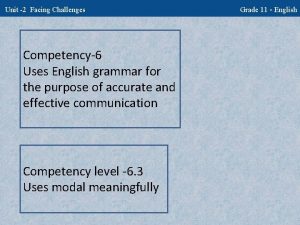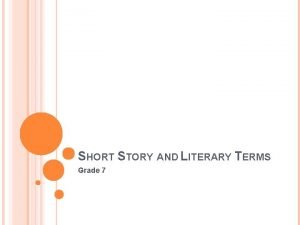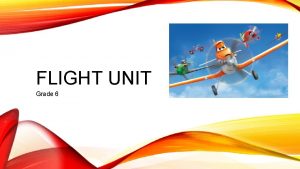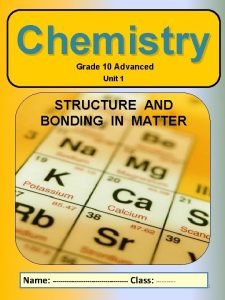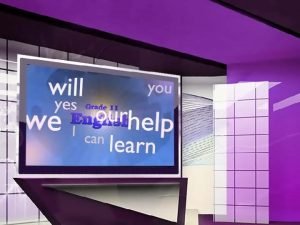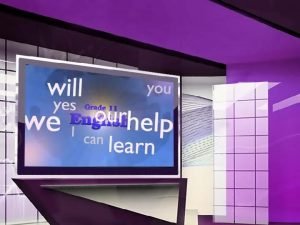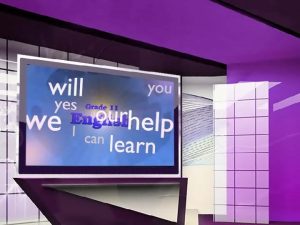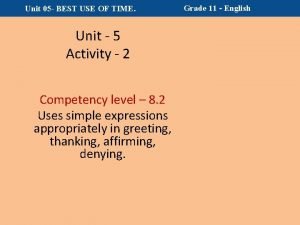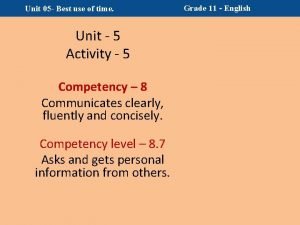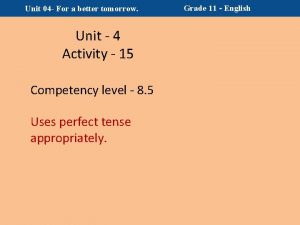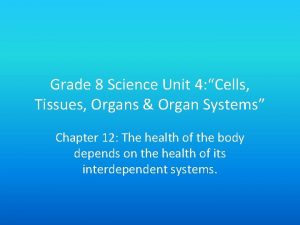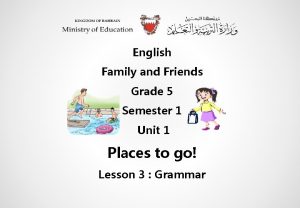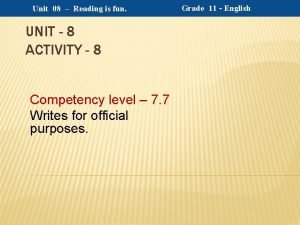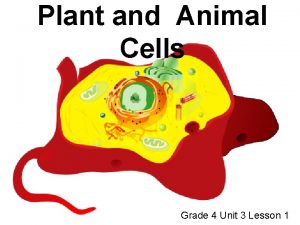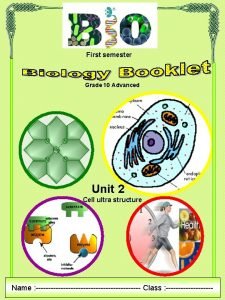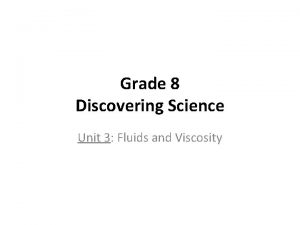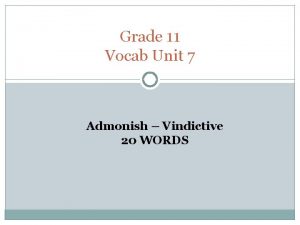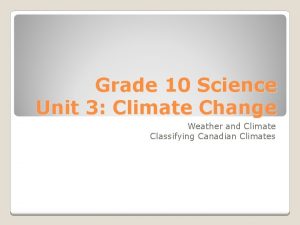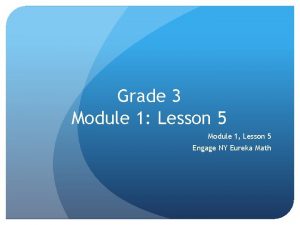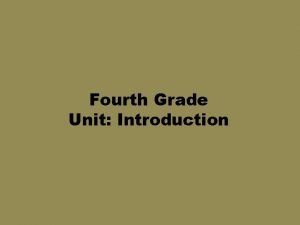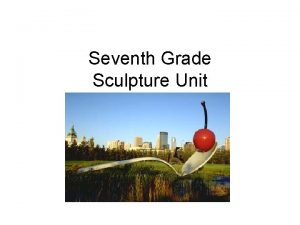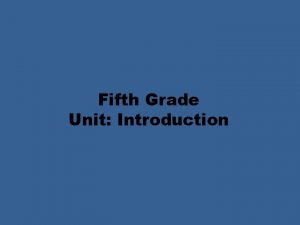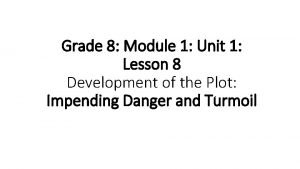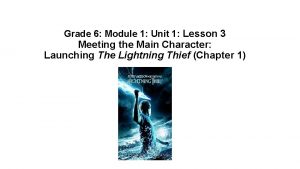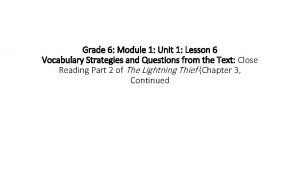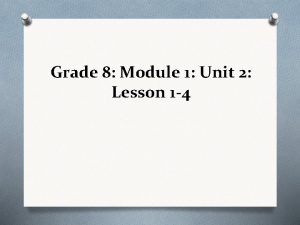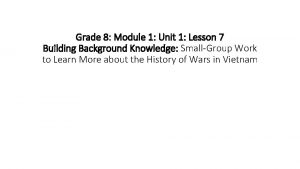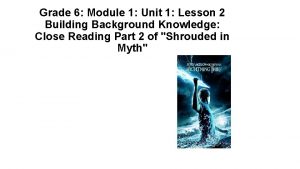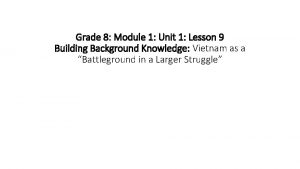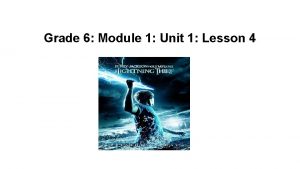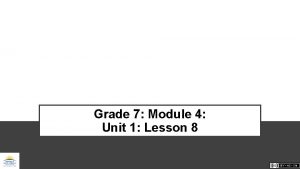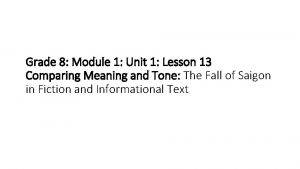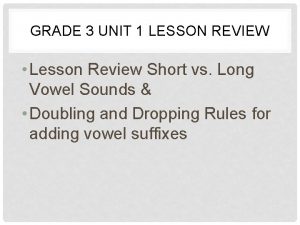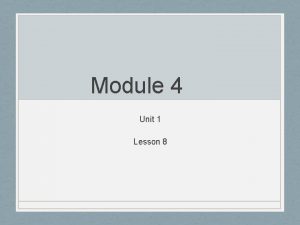6 th Grade Module D Unit 1 Lesson



























































































- Slides: 91

6 th Grade Module D Unit 1 Lesson 1 Introduction to Ecology

Ecology- the study of how living organisms interact with one another and with the environment Biotic factor- interaction between living organisms Abiotic factor- all non-living parts of the environment niche- the role a population plays in an ecosystem habitat-a place where an organism usually lives

> > - -> 3. POPULATION sim > - 4. INDIVIDUAL ple - > - > c 2. COMMUNITY only biotic sim x - ple com om ple x 1. ECOSYSTEM biotic and abiotic

1. Biome-a large region characterized by a specific type of climate and certain types of plant and animal communities 2. ecosystem- a community of organisms and their abiotic environment 3. community-all the populations of species that live in the same habitat and interact with each other 4. population-a group of individuals of the same species that live in the same place and time 5. species-a group of organisms that are closely related and can mate to produce fertile offspring

ØIndividuals within an environment often compete with each other for resources ØAll biotic and abiotic factors make up an ecosystem and determine what population can live there ØTemperature and precipitation are important factors that characterized biomes.

6 th Grade Module D Unit 1 Lesson 2 Roles in Energy Transfer

Quick Lab: Energy Role Game 1. Theobroma cacao: I live in tropical areas of South America. You may never have seen example of my species, but if you have ever had hot cocoa or eaten a candy bar, you’ve eaten some of me. What am I? What is my energy role? 2. Accipiter cooperii: I live in North America ranging from Canada to Mexico. I don’t eat bird seed and I prey on smaller animals, but sometimes I find my food at bird feeders in winter months. What am I? What is my energy role?

3. Amanita phalloides: I am a fungus that lives in dark, damp places in woodlands. I am very poisonous when eaten. I do a good job of breaking down fallen logs. What am I? What is my role? 4. Pinus ponderosa: I live in North America and have a long life span but stay in one spot my whole life. Some beetles like to eat me. What am I? What is my role? 5. Apis mellifera: I always seem to cause a buzz wherever I go. Many people find my stinger frightening. What am I? What is my role?

6. Musca domestica: I start life as an egg, become a pupa, and finally become an adult. I am commonly considered a pest and I hang out around garbage and any feed that smells whether it is good or bad. What am I? What is my role? 7. Chlamydomonas reinhardtii: I live in freshwater and like to stay near the surface. In fact, I float around all day and don’t bother anyone. If enough of us get together, we can make a pretty big, green mat on the surface of the water. What am I? What is my role?

8. Crotalus ruber: I live in the hills of Southern California. I have diamond shaped patterns on my back and cause quite the rattle if I am disturbed. I love the sun but have to hide in the shadows while I wait for a meal to come along. What am I? What is my role? 9. Dictyostelium mucoroides: You can probably guess my energy role by hearing that my common name has the word “slime” in it. I love to live in damp, dark places and don’t hurt anything. At some point in my life cycle, I produce a fruiting body to release spores. What am I? What is my role?

Producer- an organism that can make its own food by using energy from its surroundings Decomposer- an organism that gets its energy by breaking down the remains of dead organisms or animal waste and consuming or absorbing the nutrients consumer- an organism that eats other organisms or organic matter

herbivore- an organism that eats only plants omnivore- an organism that eats both plants and animals carnivore- an organism that eats animals

Energy- the ability to cause change Photosynthesis- the process of light energy from the sun is converted to food Food chain- the pathway of energy transfer from producers to consumers Food web- the feeding relationship among organisms in an ecosystem Food webs are made up of many food chains.


6 th Grade Module D Unit 1 Lesson 3 Population Dynamics

Immigration- occurs when individuals join a population Emigration- occurs when individuals leave a population

How do Populations grow • Immigration • Birth How do Populations shrink • Emigration • Death Environmental factors influence population size: • Resource Availability - Rain forest vs. Desert • Changes in Environment - Changes in weather - Natural disaster

Carrying capacity- the largest population that an environment can support at any given time Limiting factor- biotic and abiotic factors that keep a population size at a level below its full potential *if LF goes up, so does CC, if LF goes down, so does CC Cooperation- when individuals work together. Competition-when two or more individuals or populations try to use the same limited resources (food, water, shelter, space or sunlight)

6 th Grade Module D Unit 1 Lesson 4 Interactions in Communities

Predator- eats another animal Prey- an animal that is eaten by a predator Competition-when two or more individuals or populations try to use the same limited resources (food, water, shelter, space or sunlight)

Predators Eat other animals Both Have adaptations to survive Prey Are eaten by predators

Symbiosis- a close, long term relationship between different species in a community Mutualism- a symbiotic relationship in which both organisms benefit (bee & flower) Commensalism- a symbiotic relationship in which one organism benefits and the other is unaffected (lichens and tree bark) Parasitism- a symbiotic relationship in which one organism benefits and the other is harmed (tick and dog)

Module D Unit 1 Test Review Biotic Factors: living organisms in an environment EX: fish, land animals, plants Abiotic Factors: Non living parts of an environment EX: water, sun light, space, weather Limiting Factors: an environmental factor that limits that growth of an population Producer: an organism that can make its own food by using energy from its surroundings Decomposer: recycles waste materials and energy from living and dead organisms. Community-all the populations of species that live in the same habitat and interact with each other

Food Chain: traces a path of energy transfers from producers to consumers Predator: eats another animal Prey: an animal that is eaten by a predator Competition: the struggle for limited resources by the members of a community in an ecosystem. Commensalism: a symbiotic relationship in which one organism is benefited and the other is neither benefited or harmed. (+ 0)

Ecosystem v. Biome: a biome may contain many ecosystems Niche v. Habitat: a niche is the organism's role within the habitat. How do consumers get energy? Consumers get energy by eating other organisms. How can environmental changes affect organisms? Environmental changes such as fire will decrease the amount of resources available, thus decreasing the number of organisms in that environment. How can limiting factors limit the size of a population? Limiting factors will make some organisms unable to survive.

6 th Grade Module D Unit 2 Lesson 1 Land Biomes

Biome-a region of earth where climate determines the type of plants and animals live there. Grassland- a biome that has grasses and few trees Desert- biome that is very dry, soil may be rocky or sandy Tundra- biome with low average temperatures and very little precipitation, the ground contains permafrost (a thick layer of permanently frozen soil beneath the surface) Taiga- biome with low average temperatures and more precipitation than tundra, the soil layer is thin, acidic and nutrient-poor

Earth’s Major Land Biomes

Tundra Plants have shallow roots that grow above the permafrost • Some animals migrate or hibernate • Animals like the musk oxen have thick fur and fat deposits that protect them from the cold

Taiga Trees have needlelike leaves to conserve water and produce food all year Some animals experience a change in fur color as the seasons change

Coniferous tree- trees with evergreen, needle like leaves

Desert • Plants and animals have adaptations to let them conserve water and survive in the extreme temperatures • Some animals burrow underground or find shade during the day • Many desert animals are active only at night

Tropical Grassland • High average temperatures • Periodic grass fires • Wet and dry seasons • Animals migrate to find water • Thin soil • Grazing animals • Predators

Temperate Grassland • Moderate precipitation • Hot summers and cold winters • Soil rich in nutrients • Occasional grass fires

Temperate Deciduous Forest • Moderate precipitation • Hot summers, cold winters • Located in northeastern United States, East Asia and much of Europe • Nutrient rich soil • Some animals migrate, some hibernate and some are active during winter

Deciduous tree- broad leaf trees that drop their leaves as winter approaches

Temperate Rain Forest • Have a long cool wet season and a relatively dry summer • Exist in the Pacific Northwest and the western coast of South America • Nutrient rich soil • Forest floor is covered in mosses and ferns

Tropical Rain Forest • Located near the equator • Warm throughout the year • Receives more rain than any other biome • Soil is low in nutrients

6 th Grade Module D Unit 2 Lesson 2 Aquatic Ecosystems

3 Aquatic Ecosystems • Freshwater Ecosystems – Rivers, lakes and wetlands • Marine Ecosystems – oceans • Estuaries – Rivers and oceans form estuaries

Freshwater Ecosystems: • Lakes and Ponds – Algae, amoebas, frogs, clams, bacteria , worms, turtles, fish and ducks • Wetlands – Cattails, duckweed, moss, orchids, willows, duck, shrews, herons, and alligators • Rivers and Streams – Aquatic plants, mosses, water bugs, fish

Bogs Contain decomposing vegetation s e rsh a M Contain grasslike plants Areas of land saturated with water at least part of the year. Sw am ps Contain trees and vines

Wetland- an area that is saturated or soaked with water for at least part of the year. Ex: bogs, marshes, or swamps Estuary- a partially enclosed body of water formed where a river flows into an ocean, contains fresh and salt water

Estuaries: • Organisms in estuaries must be able to survive in constantly changing salt levels • Sea grasses, mangrove trees, fish, oysters, mussels and water birds

Marine Ecosystems: • Coastal oceans – Intertidal zones: • Beaches and rocky shores, • Exposed to the air and lots of wave action and changing temperature • Crabs and sea grasses – Neritic Zone • Underwater zone from the shore to the continental shelf • Has lots of sunlight • Algae, many plants, coral reefs, kelp forest, colorful fish, anemones

• Open oceans – Bathyal Zone • Starts and the end of the continental shelf to a depth of about 6, 562 feet • Dark, cool water • Majority of sea life is found here. • Sharks, whales, dolphins, fish, sea turtles • Deep oceans – Abysmal Zone • The ocean below 6, 562 feet • No light reaches the deep ocean • Some species living here have bioluminescence • Microorganisms living near the hydrothermal vents use chemicals in the water as an energy source

Neritic zone

1. 2. 3. 4. 5. 6. 7. 8. 9. 10. 11. 12. 13. 14. 15. 16. Biome in a Box options: Desert - Gerardo Tundra - Delaney Tiaga - Valeria Tropical Grassland - Jorge Temperate Grassland - Quiana Temperate Deciduous Forest-Brittany Temperate Rain Forest - Savannah Tropical Rain Forest - Joseph Wetland Estuary Lakes/ Ponds - Victor Rivers Intertidal Ocean Zone - Jennifer Nertic Ocean Zone - Jizel Bathyal Ocean Zone - Isaias Abysmal Ocean Zone- Pamela

6 th Grade Module D Unit 2 Lesson 3 Energy and Matter in Ecosystems

Energy- the ability to do work and play Matter- anything that has mass and takes up space Law of Conservation of Mass- Mass cannot be created or destroyed, in ordinary physical and chemical changes Law of Conservation of Energy- Energy cannot be created or destroyed, but it can be changed from one form to another

Energy Pyramid Energy pyramid- a tool that can be used to trace the flow of energy through an ecosystem

Type of Organism: How it gets energy: Use energy from the sun Producers: Consumers: Decomposers: Get energy by eating other organisms Get energy by breaking down the remains of other organisms

Water cycle-the continuous movement of water between the atmosphere, the land, the oceans and living things Condensation Precipitation Transpiration` Evaporation f f o n Ru Respiration Ground Water

Nitrogen Cycle Nitrogen cycle- the cycling of nitrogen between organism, soil, water and the atmosphere

Carbon cycle- the movement of carbon from the nonliving environment into the living things and back

th 6 Grade Module D Unit 2 Lesson 4 Changes in Ecosystems

Eutrophication- the process by which organic matter and nutrients slowly build up on a body of water. Succession- the slow development or replacement of an ecological community by another ecological community over time. Pioneer Species- the first organisms to live in an uninhabited area. Biodiversity- the number and variety of species that are present in an area

1. Bare Rock Primary Succession: 2. Lichens form on rocks, break it down in to particles (soil) 3. Mosses and insects move in after many years 4. Large plants grow as the soil deepens 5. A Forest grows after hundreds and thousands of years

Secondary Species- takes place were soil and some plant life exist • Year 1: the farmer stops farming, wild plants start to grow • Year 2: new wild plants grow • Years 5 -15: some conifer trees start to grow • Year 100: a forest is now growing where the farm was

Visual Summary • A pond fills with organic matter during ________. eutrophication lichens • In primary succession, _____ grow on bare rock. plants • Soil in damaged ecosystems enables ______ grow right away. • Many mature ecosystems are dominated by a climax species community of __________.

th 6 Grade Module D Unit 2 Lesson 5 Human Activity and Ecosystems

Urbanization- human population growth in and around cities Biodiversity- number variety of organisms in a habitat Resource Depletion- occurs when a large fraction of a resource has been used up Pollution- caused by any material or condition that harms the environment Eutrophication- overgrowth of plants caused by addition of excessive nutrients into a body of water

Invasive Species- an exotic species that outcompetes the native species

Exotic Species- a species that is not native to a particular region Stewardship- responsible care of Earth and its resources Conservation- protection and wise use of natural resources

Energy Pyramid- (know how to read an energy pyramid and know which animals are on top) Depletion- when a large fraction of specific resource is used up. Law of Conservation of Energy- energy cannot be created or destroyed but can be changed. Eutrophication- causes nutrients to build up in a pond Tundra- biome with snow foxes and snow Tropical Rain Forrest- biome with warm conditions and more than average rain fall. Adaptations- an organisms ability to change in a changing environment.

Conservation- the protection and wise use of natural resources. Biological diversity- a rain forest has the greatest biological diversity. Parts of the Aquatic Ecosystem Estuary Freshwater Saltwater Location of 4 ocean zones know where the intertidal zone is located.

Adaptation of a lily pad long roots How do we practice conservation? Walking/riding bikes, reducing the use of resources, composting waste, recycling, Water quantity? ? Construction of a dam

TOOL TIME: • Select a real life problem • Summit a journal – Name of tool – Strengths and weaknesses – Development? Testing? Modifications? – Alternate Uses? • Summit the design for your original model of the tool – Paten? • Have appropriate visuals – Communicate Clearly

Journal: Piggy Fleece I have a problem at my house with my guinea pigs going through a lot of bedding and the bedding is often very smelly. I am have researched CarefreshⓇ bedding and found this product claims to reduce the odor of the Guinea pigs urine by adding baking soda to the bedding. The Carefresh is made from a paper product which means it is recyclable and better for the animals. It is also dust free since it does not contain wood shavings. These are pros for the Carefresh. However, it can be expensive. I found it runs around $20. 00 for a package, this price is for a 60 L bag. It can also be messy. Pieces of the bedding can be kicked out the enclosure and end up on the floor. This is messy and unsanitary because the guinea pigs are using this product much like we use toilet paper. When it falls on the floor it can be stepped on and then carried to other parts of the house.

Presentation:

th 6 Grade Module D Unit 3 Lesson 1 Earth’s Support of Life

Photosynthesis- plants convert carbon dioxide and water to oxygen and glucose Atmosphere- a mixture of gasses that surround a planet, moon or other space object Ultraviolet Radiation- a harmful radiation that can damage genetic material in organism Ozone- a molecule that is made up of three oxygen atoms

Water Filter Lab • activated charcoal • mesh or screening material • sponges • paper • tape • cotton balls • fabric scraps • sponges • 1 -liter bottles

th 6 Grade Module D Unit 3 Lesson 2 Natural Resources

Natural resource- any natural material used by people, made by God (air, soil, minerals, water, oil, plants and animals) Renewable resources- a natural resource that can be replaced at the same rate at which it is consumed (solar, water and wind) Inexhaustible resources- resources that can never be used up (solar energy, and wind energy) Nonrenewable resources- a resource that forms much more slowly (Iron ore and copper)

Fossil fuel- a nonrenewable resource formed by buried remains of plants and animals (coal, oil and natural gases) Material Resources- resource used to make objects, food or drink (cotton, metal, plants, wheat, animals and water) Energy Resources- a natural resource that humans use to generate energy Potential Energy- stored energy Kinetic Energy- energy of movement

When does Potential Energy change Kinetic Energy? • When coal burns to produce electrical energy in a power plant • When your body digest food to give you energy • When water falls over a dam to power a generator that produces electrical energy in a power plant • When natural gas causes water to boil in a pan on a stovetop • When a rollercoaster speeds down a hill after stopping at the top of the hill

How does Energy convert? What if the battery was rechargeable?

th 6 Grade Module D Unit 3 Lesson 3 Nonrenewable Energy Resources

Energy Resources-a natural resource that humans use to generate energy (can be renewable or nonrenewable) Fossil Fuels- a nonrenewable resource that forms from the remains of organisms that lived long ago Nuclear Energy- the energy released when the nuclei of atom are split or combined. Fission- the process by which a nucleus splits in two or more fragments and releases neutrons and energy

Types of Fossil Fuel: How fossil Fuels are converted to be used: Petroleum/ Crude Oil: Used in Gasoline, Kerosene, and Diesel Fuels and other heating oils Natural Gas: Used in gas stoves, and propane grills. Also used to heat homes because it is inexpensive Coal: Most widely used fossil fuel. Most power plants burn coal to generate electrical power.

• Fossil fuels are burned to generate heat energy • Heat energy is converted to electrical energy • Electrical energy is used in everyday life.

Fossil Fuels: + inexpensive to obtain - Coal mining and oil spills disrupt habitats - Coal mining can lower water quality - Burning fossil fuels can cause acid rain and smog Nuclear Fuels: + produces a large amount energy + no air pollution + mining uranium does not disrupt habitats - difficult to safely store waste -must be stored for 1, 000 s of years - potential for radiation leaks - Disruption to ecosystem from excessive heat

th 6 Grade Module D Unit 3 Lesson 4 Renewable Energy Resources

Energy resource- a natural resource used to generate electricity and other forms of energy Wind energy- uses the force of moving air to drive an electric generator or do other work Hydroelectric energy- electrical energy produced by moving water. Solar energy- energy received from the sun in the form of radiation Biomass- organic matter from plants and from animal waste that contains chemical energy Geothermal energy- energy produced by heat from the earth’s interior

Pros and Cons of Renewable Energy Resources to Produce Electricity: Advantages: + Most do not produce pollution during use Disadvantages: - The technology is expensive to produce and maintain

th 6 Grade Module D Unit 3 Lesson 5 Managing Resources

Natural resources- anything that can be used to take care of a need. Water, minerals, air, oil are a few examples Renewable resources- can be replaced quickly. Water, wind, sunlight, trees, and fish Nonrenewable resources- are used faster than they can be replaced. Coal, minerals, oil and natural gas are examples Stewardship- the careful and responsible management of resources Conservation- the protection and wise use of natural resources

Unit 3 Test Review Biomass- organic matter from plants and from animal Material Resource- resource used to make objects, food or drink (trees, cotton, animals) Nonrenewable Resource- are used faster than they can be replaced. Ozone- a molecule made up of three atoms of oxygen Energy Resource- natural resource that humans use to generate energy *Sources: water, solar, wind, fossil fuels *These are natural resources because they occur naturally in nature and are used by people. We use Energy Resources to produce heat, generate electricity

Energy Transformation: plants convert sunlight into stored chemical energy that is released when fossil fuels are burned. Sulfur dioxide in the atmosphere leads to pollution by combining with rain to form acid rain Most garbage ends up in landfills and in the oceans. A power plant generated by geothermal energy uses water heated by magma, pumped from beneath the Earth’s surface. Nuclear energy used to generate electricity through the process of steam produced by heat that turns generators. It is important to manage our natural resources because the growing human population is putting increased demands on natural resources.

HUMAN IMPACT ON WATER • You need 2 positive and 2 negative affects humans have on the following:
 Grade 6 module
Grade 6 module Grade 6 module
Grade 6 module Grade 5 module 1 lesson 1
Grade 5 module 1 lesson 1 Grade 6 module 1: unit 2 answer key
Grade 6 module 1: unit 2 answer key What is sand made of
What is sand made of C device module module 1
C device module module 1 Hyp opp adj
Hyp opp adj Unit 10, unit 10 review tests, unit 10 general test
Unit 10, unit 10 review tests, unit 10 general test Grade 10 english module 4 pre test answer key
Grade 10 english module 4 pre test answer key Principles of marketing
Principles of marketing Grade 12 accounting fixed assets
Grade 12 accounting fixed assets Grade 8 module 1
Grade 8 module 1 Business math grade 11 module 3
Business math grade 11 module 3 Grade 11 balance sheet
Grade 11 balance sheet Grade 8 module 3
Grade 8 module 3 Accounting module grade 11
Accounting module grade 11 A story of ratios
A story of ratios Example of contextualization and localization
Example of contextualization and localization Story of units
Story of units Eureka math 3rd grade module 7
Eureka math 3rd grade module 7 Reading and writing grade 11 module 6
Reading and writing grade 11 module 6 The great depression lesson 2 hardship and suffering
The great depression lesson 2 hardship and suffering Module 5 lesson 5
Module 5 lesson 5 Practical/logistical issues in relationships
Practical/logistical issues in relationships Module eleven lesson one self check quiz
Module eleven lesson one self check quiz Eureka math algebra 1 module 1 lesson 15
Eureka math algebra 1 module 1 lesson 15 Segment relationships in circles lesson 15-4
Segment relationships in circles lesson 15-4 Module 3 lesson 6
Module 3 lesson 6 Module 26 how we learn and classical conditioning
Module 26 how we learn and classical conditioning Outdoor unit module protection error
Outdoor unit module protection error Initial grade to final grade
Initial grade to final grade Cinderella dressed in yellow went upstairs to kiss a fella
Cinderella dressed in yellow went upstairs to kiss a fella Difference between grade a and grade aa eggs
Difference between grade a and grade aa eggs Grade a vs grade b milk
Grade a vs grade b milk Grading of grapes
Grading of grapes Low grade and high grade metamorphic rocks
Low grade and high grade metamorphic rocks Grade 7 natural science test term 3
Grade 7 natural science test term 3 Maps and scales grade 12
Maps and scales grade 12 Creative arts grade 8 exam papers 2021
Creative arts grade 8 exam papers 2021 Wordly wise 4th grade lesson 3
Wordly wise 4th grade lesson 3 Natural science and technology grade 6 term 4
Natural science and technology grade 6 term 4 Natural science grade 7 term 2 matter and materials
Natural science grade 7 term 2 matter and materials Metals and non metals grade 5
Metals and non metals grade 5 Grade 6 natural science and technology term 2
Grade 6 natural science and technology term 2 Lesson plan in entrepreneurship grade 6
Lesson plan in entrepreneurship grade 6 Animal skeleton grade 5
Animal skeleton grade 5 Wjec criminology unit 4 revision
Wjec criminology unit 4 revision Kishan
Kishan Unit 7 class 11 english
Unit 7 class 11 english Moral social and cultural studies grade 9
Moral social and cultural studies grade 9 History grade 10 unit 7
History grade 10 unit 7 Which of the following adaptations helps birds fly?
Which of the following adaptations helps birds fly? Grade 7 science unit 2
Grade 7 science unit 2 Grade 11 english workbook activity answers
Grade 11 english workbook activity answers Types of reactions grade 11
Types of reactions grade 11 The first semester exam grade 10
The first semester exam grade 10 Chemistry grade 10 unit 4
Chemistry grade 10 unit 4 Unit 3 personal and business finance grade boundaries
Unit 3 personal and business finance grade boundaries Unit 4 criminology
Unit 4 criminology Unit 10 english class 11
Unit 10 english class 11 Grade 11 english pupils book answers unit 8
Grade 11 english pupils book answers unit 8 New gcse grades
New gcse grades Grade 4 english unit 8
Grade 4 english unit 8 Grade 11 english notes
Grade 11 english notes Grade 11 english pupils book unit 7 answers
Grade 11 english pupils book unit 7 answers Grade 11 unit 2
Grade 11 unit 2 A story for grade 7
A story for grade 7 Types of mixtures
Types of mixtures Grade 6 flight
Grade 6 flight Three characteristics of metals
Three characteristics of metals Kyrene educational resources
Kyrene educational resources Unit 7 grade 11
Unit 7 grade 11 Unit 10 english class 11
Unit 10 english class 11 English 11 unit 10
English 11 unit 10 Grade 11 english unit 5
Grade 11 english unit 5 Grade 11 english unit 5
Grade 11 english unit 5 Grade 11 unit 4
Grade 11 unit 4 Grade 8 science unit 4
Grade 8 science unit 4 Family and friends grade 5 unit 1
Family and friends grade 5 unit 1 Unit 8 formal and informal letters
Unit 8 formal and informal letters Plant cell grade 4
Plant cell grade 4 Literary devices in shall i compare thee
Literary devices in shall i compare thee Biology grade 10 unit 2
Biology grade 10 unit 2 Grade 8 science fluids
Grade 8 science fluids Admonish sentence
Admonish sentence Unit 3 climate
Unit 3 climate Lesson outline lesson 3 describing circuits answers
Lesson outline lesson 3 describing circuits answers Lesson outline lesson 3 mountain building answers
Lesson outline lesson 3 mountain building answers Lesson outline lesson 2 aquatic ecosystems answer key
Lesson outline lesson 2 aquatic ecosystems answer key Meaning of micro teaching
Meaning of micro teaching Ihi l 101
Ihi l 101 A gift of chappals ppt
A gift of chappals ppt
